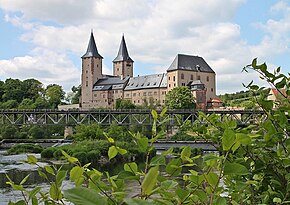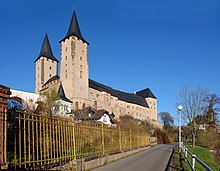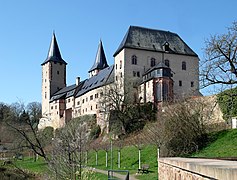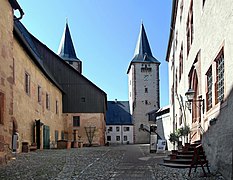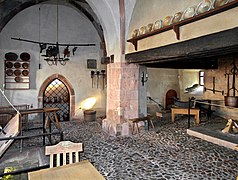Rochlitz Castle
The Rochlitz Castle is located in the west of the city Rochlitz in mittelsachsen of the Free State of Saxony . On the site of an imperial castle , which was built in the second half of the 10th century and passed into the possession of the Wettin margraves in 1143 , an extensive palace complex rises. In addition to several Romanesque parts of the building, its shape is largely due to a Gothic conversion into a margravial palacedetermined in the last quarter of the 14th century. Further renovations and new buildings were made at the end of the 15th and 16th centuries, when the castle was used as a secondary residence, widow's seat and hunting lodge for the Wettins. In total, the castle or palace was eight times the residence for members of the Saxon dynasty. From the 18th century the castle served as the seat of the authorities (judicial office, district court), from 1852 also as a prison , for which major renovations were necessary again. The museum, founded in 1892, was gradually expanded and will in future occupy almost the entire castle.
location
The castle is located southwest of the historic center of Rochlitz on a gradually sloping east-northeast foothills of Rochlitz mountain , that of the river Mulde in the southeast and the Light stream in northwest flanked. The spur divides into the Noßwitzer Schlossberg in the west, which is about 200 m above sea level. NN is considerably higher and covers an area of about 300 m in length and about 60 m in width and - separated by a late medieval neck ditch - the Rochlitz castle mountain with the castle complex (about 90 × 30-40 m), the so-called lower castle and separated by ditches the eastern outer bailey with the St. Petri Church and a total extension of about 220 × 40 m.
history
Rochlitz Castle in the Middle Ages
The castle was formed in Central and spätslawischer time the center of the Slavic Small gaus Rochlitz. Archaeological finds suggest that on the Nosswitzer Schlossberg, which adjoins today's castle to the west, there was a rampart from the 9th and 10th centuries as a predecessor of the German castle, which was later converted into a western outer bailey ( suburbium ). The area on the Mulde probably came under German rule under King Heinrich I. In the second half of the 10th century, the establishment of a Burgward took place , the center of which was Rochlitz Castle. As a mission and parish church for the entire Burgward, the St. Petri Church in the eastern outer bailey (suburbium) was founded by the Merseburg diocese before 981. In 995, the Rochlitz area is listed in a certificate from Emperor Otto III. First mentioned in writing when, after the dissolution of the diocese of Merseburg, the Zwickauer Mulde was determined as the border between the dioceses of Naumburg and Meißen .
The Rochlitz castle complex - originally certainly an imperial estate - and the surrounding area came to Margrave Ekkehard von Meißen as allodial possession around 1000 . In the dispute between his two sons Count Hermann (1009 to around 1031/32) and Ekkehard II and their uncle Margrave Gunzelin over the inheritance, Gunzelin set the castle urbs Rochelenzi on fire in 1009. The entry in the chronicle of Bishop Thietmar von Merseburg , who reports on the feud , is also the first direct mention of the castle. In May 1018 Thietmar went to the southeastern part of his diocese and took the property of the Merseburg church in the Rochlitz area back into his care. In addition, he most likely made confirmations in the Petrikirche .
In 1046 the Ekkehardinian possessions returned to the empire through reversion and were replaced by King Henry III. combined with the rest of the imperial estate on the Mulde, to which, in addition to Rochlitz, the Burgwarde Colditz , Leisnig , Polkenberg and Döben (Grobi) belonged. In the same year Heinrich gave his wife Agnes to him possessions inherited from Margrave Ekkehard, including in burchwardo Rochidez . Rochlitz developed into an important Salian imperial castle in the second half of the 11th century , for which at least two royal and imperial stays are documented. In addition to Heinrich III. also documented his son King Henry IV on October 28, 1068 actum Rochlezi . Controversial is a deed of gift of Emperor Henry IV. From the year 1074, in which he, among other things castellum Rochedez cum adiacente pago similiter nominato the diocese of Naumburg , should have transferred since the diploma probably traced in the second half of the 12th century, while verunechtet was .
In 1143, Margrave Conrad I of Meißen received the castle and the Rochlitz province ( provincia Rochelez ) as a gift from King Conrad III. to own. Thus the castle came to the House of Wettin , where it remained until 1918. After Konrad's abdication in 1156 and his retirement to the Augustinian canons on the Petersberg near Halle , the property was divided among his five sons. The county of Rochlitz came together with the county of Groitzsch, which was only partially won in 1135 for the Wettins, to Dedo V the Feisten . Although he called himself Graf von Groitzsch ( comes de Groiz ), he probably did not reside in what is now called the Wiprechtsburg , but in Rochlitz. Under his rule, the country was expanded in the Rochlitz region and shortly after 1160 the Zschillen monastery was founded in proprio suo videlicet pago Rochelez in ripa Milde fluminis . Below Rochlitz Castle, Dedo or one of his sons Dietrich and Konrad founded the legal town of Rochlitz with the town church of St. Kunigunde. The castle itself served as the residence of an apparently not insignificant court , among which even a Henrichs burggravius de Rochlitz and several castrenses de Rochlitz appear in 1208 . Extensive Romanesque building parts such as two residential towers and the palace in the south wing date from this time .
After the male line of Rochlitz died out, the county fell back to the main Wettin line in 1210 and was reintegrated into the Margraviate of Meißen by Margrave Dietrich von Meißen . Rochlitz remained an important fortified point within the framework of the Wettin rule and the administrative seat of the Rochlitz office , but overall it should have decreased in importance. In 1223 the castle was conquered by the Thuringian Landgrave Ludwig IV. A siege castle was built and a Blide was installed. Between 1286 and 1291 the Count Palatine Friedrich von Sachsen-Lauchstädt resided here , in 1288 he kept his father Landgrave Albrecht II the Degenerate in prison in Rochlitz. Between 1296 and 1298 the castle once again belonged to the empire for a short time . In 1298, the Palatine and Margrave Friedrich returned from his exile in Tyrol. Meißnian troops conquered the castle and captured the royal governor for the Mark Meißen, Heinrich von Hessen , a cousin of the king. In 1325 and 1329 Frederick the Serious held court in Rochlitz.
Rochlitz experienced a further boom under the ruling brothers Friedrich , Balthasar and Wilhelm. Margrave Wilhelm I the One-Eyed had a sophisticated Gothic palace built here in the last quarter of the 14th century , comparable to the front palace he built at Mildenstein Castle , which he hardly used himself. This includes the construction of the Princely House from 1375 to 1380 and the two towers called "Jupen" around 1390 as well as the renovation of the transept with the chapel and the south wing. These new buildings and conversions to the margravial " sloß " (first called around 1370) still determine the picture today. At that time, the facility served as a main payment office for the margraviate, as a financial archive for the Freiberg clerks and, from 1384, as a place of jurisdiction for a peace .
In 1430 the castle and town had to be defended in the event of a Hussite invasion, but while the town fell, the castle was held. After staying here for a longer period in 1436, Duke Sigismund, who had been deposed as Bishop of Würzburg , lived here in exile, befitting his status. In addition, the castle served temporarily in 1457 as a prince school for Ernst and Albrecht and in 1477 for Friedrich (later the sage) and Johann (the constant) . In the second half of the 15th century (from 1477 to 1480) there was a further reconstruction into a permanent castle, in which from 1481 to 1501 the Duchess Amalia of Saxony , the widow of Duke Ludwig the Rich of Bavaria-Landshut and sister of Ernst and Albrecht of Saxony, resided. The reconstruction of the castle chapel (around 1480) and the new construction of the Petrikirche (1470/99) also fall during this period. From 1507 to 1510 the castle served as the residence for the Grand Master of the Teutonic Order Friedrich von Sachsen. In 1511, Margrave Albrecht von Brandenburg-Ansbach from the Franconian line of the Hohenzollern in Zschillen was accepted into the Teutonic Order and the next day he was made his successor as Grand Master at Rochlitz Castle.
Rochlitz Castle in modern times
The palace and town experienced a cultural high point when the Dowager Duchess Elisabeth of Hesse , an important supporter of the Reformation in Saxony, took her seat here from 1537 to 1547 . She was followed from 1586 to 1591 by Elector Christian I and from 1591 to 1611 by Elector Widow Sophie . During this time, the complex was converted into a hunting lodge with redesigns of the Princely House in 1537/47 and from 1586 as well as the construction of the “Small House” in 1588. Before 1548, a Renaissance pleasure garden with pleasure house and vineyards was laid out on the upstream Schlossberg .

During the Thirty Years' War , the castle was besieged and taken several times by Swedish troops, which can still be seen today when cannonballs hit the “Finsteren Juppe”. The lower castle, which had also been built up until then, was also destroyed by fire in 1645. In 1693, at the request of Elector Johann Georg IV , Emperor Leopold I raised his mistress Magdalena Sibylla von Neitschütz to Countess of Rochlitz. During the Great Northern War in 1706/07, the Swedish King Charles XII elected. Rochlitz twice as residence and Swedish garrison headquarters. Three years later, Queen Christiane Eberhardine of Poland , the wife of August the Strong , took her travel quarters here. Apart from the construction of the castle bridges in 1718, the 18th century meant a sharp decline with the final demolition of the lower castle in 1717 and in 1784 even other parts of the castle itself such as the upper floor of the palace, the fountain and granary and other components.

In 1848 a watch command of 22 riflemen and later infantry was stationed in the largely unused castle. From 1850 it was also the seat of a district court, in which numerous inmates were incarcerated after the revolution of 1848 ("May prisoners"). In 1852 the prince's house and the transept were converted for the judiciary and the prison cell building, which was used until 1961, was built. In 1893, the Rochlitz secondary school teacher Dr. WC Pfau (1862–1946) opened a museum in the castle chapel , the fourth oldest castle museum in Saxony.
From 1934 to 1936, during the Nazi era (“Third Reich”), extensive renovation measures were carried out as part of the “Rheinhard Program” (= Reich Labor Service), at the end of which was the development of the Lichten Jupe as a lookout tower. In 1944/45 Rochlitz Castle was the relocation site for art and cultural assets from the Dresden State Archives , the Leipzig University Library and the Leipzig Museum of Fine Arts (numerous losses after 1949).
After the capitulation, from April to June 1945 there was a United States Army reception camp for prisoners of war and NSDAP functionaries, which was converted into an NKVD headquarters and camp from July 1945 to May 1947 after the area was taken over by Soviet troops . After its closure, the museum was able to reopen in May 1948, but extensive losses were recorded due to looting and improper handling. During the GDR era, the palace was transferred from the GDR Ministry of Justice to the city administration in 1960 and experienced various uses as a residential building, office, city archive, museum and, from 1963/64, also as a school day care center. In 1960 building research and the expansion of the museum began by the museum director Udo Baumbach and volunteers.
A significant change for the castle was the move of the district court in 1990 (as part of the reunification ) and the subsequent demolition of the cell building with the reconstruction of the north weir corridor . When it was taken over by the State of Saxony and the State Enterprise State Palaces, Castles and Gardens of Saxony in 1994, extensive security measures, renovations and restorations began. To this end, the Free State invested around € 16 million by 2014. In connection with the renovation work, extensive archaeological investigations and building research are carried out.
photos
literature
- Stefan Reuther: Rochlitz Castle - impressions from the 1000-year history of construction and use. in: Mitteilungen des Landesverein Sächsischer Heimatschutz, issue 2/2015, pp. 16–23.
- Udo Baumbach: Rochlitz Castle and the Soviet Secret Police. Beucha 2014, ISBN 978-3-86729-133-0
- Hendrik Bärnighausen (arrangement): Rochlitz Castle. Restoration and preservation of monuments . (= Workbook. State Office for Monument Preservation Saxony 19). Beucha [u. a.] 2013.
- André Thieme: Castle, rule and office of Rochlitz in the Middle Ages. Historical development and manorial structures of a late medieval-early modern Wettin secondary residence (widow's seat) , in: Martina Schattkowsky (ed.) Widowhood in the early modern period. Princely and noble widows between foreign and self-determination. Writings on Saxon History and Folklore Vol. 6, Leipzig 2003, pp. 35–64.
- Udo Baumbach: Rochlitz Castle. Princely residence, widow's seat, place of exile. Saxony's most beautiful palaces, castles and gardens 14, Leipzig 2002, ISBN 3-361-00549-3 .
- Stefan Reuther: Building activity at Rochlitz Castle in the second half of the 15th century , in: Late Gothic castle construction in Central Germany. Conference proceedings. Dresden 2007, pp. 146–154.
- Udo Baumbach; Stefan Reuther: The Princely House of Rochlitz Castle, a representative hall building around 1375/80 . In: Burgenforschung aus Sachsen (1998), pp. 187–199.
- 1000 years of Rochlitz . Festschrift, Beucha 1995, ISBN 3-930076-16-0
- Udo Baumbach: Rochlitz Castle. A guide through the castle, museum and history. Sites of Saxon art and history. Beucha 1995, ISBN 3-930076-10-1 (The information on the building history in the Middle Ages is in part already outdated by the current building history studies).
- Roman Grabolle: Pottery from Rochlitz Castle (Saxony) . In: Ottonian ceramics. Goods and forms of the 10th century from North, East and Central Germany, Pomerania, Silesia and Bohemia. On the current state of research. Workshop from 18. – 19. June 2001 at the Humanities Center for the History and Culture of East Central Europe V. Leipzig, Leipzig 2001
- Frank Schmidt: Rochlitz Castle. Leipzig 2013, ISBN 3-361-00688-0
- Wolf-Dieter Röber , Steffen Winkler: Rochlitz Castle . In: Series of publications, Issue 6, Museum and Art Collection Schloss Hinterglauchau, City of Glauchau, 1986, GDR, pp. 35–39 (on the history and construction history of the castle, its owners and their history of use, with three images of the conditions during the GDR period)
Web links
- schloss-rochlitz.de - Official website of Rochlitz Castle, State Palaces and Castles in Muldental, with a virtual tour and a list of literature
Individual evidence
- ↑ Rochlitz Castle Timeline ( Memento from July 17, 2013 in the Internet Archive )
- ↑ Peter Bäumler: "Jupen" double pack as a trademark, Dresdner Latest News from September 1, 2014
Coordinates: 51 ° 2 ′ 42 " N , 12 ° 47 ′ 29" E
